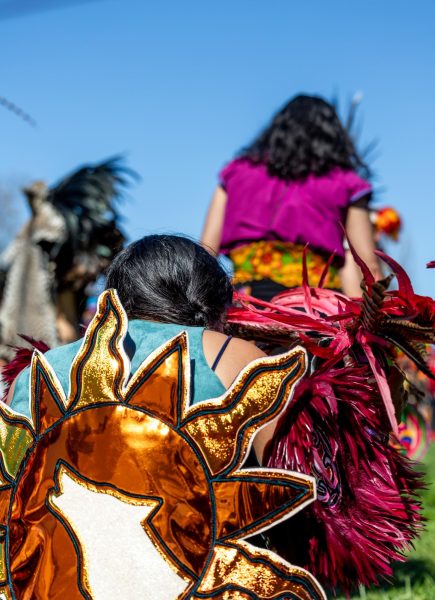Silence. A few taps on the keyboard, a click and another silent pause. Suddenly, the door swings open and a student enters, rushing into the college counseling office. As they check in, the woman at the front desk greets them with a smile.
Rae Ann Prado has worked as Harker’s college counseling support specialist for 10 years. Unbeknownst to most students, she spends her hours outside the office diving into the powerful, pulsing art of Aztec dance.
Aztec dance immerses audiences in a rich sensory experience. A resonant drumbeat lays the rhythmic foundation upon which a flute or a voice provides a melody. The choreography is intertwined with the music: dancers attach hard shells from the ayoyote tree to their ankles, creating a resounding, percussive beat. Flowing headdresses, traditionally made from quetzal feathers and gold, sway elegantly in unison. Lastly, members of the dance group stride around in a circle, each holding a pot of smoldering incense that diffuses smoky herbal scents into the air.
“I started dancing in my 20s, but it was a huge commitment,” Prado said. “I was dancing for a while and then stopped to raise my family and my kids. It had been about 15 years before I went back and started again because all my kids were out of high school.”
Prado dances with a group called Calpulli Ocelocihuatl, which she co-founded in late 2023. Her previous dance group, Calpulli Tonalehqueh, performed for public events like protests at City Hall as well as for private events like quinceaneras, weddings and parties.

“Forming my own group has been something that I had wanted to do for a long time,” Prado said. “We thought that by starting anew, we could give more inclusion to different groups that weren’t being offered with my older, bigger group.”
As co-founder, Prado leads the group as the second in a line of six leaders. When recruiting new members to join their organization, Prado and her co-heads kept the Calpulli open to all ages, striving for almost familial unity.
“My group is women-led, but we also have men, elders and young children,” Prado said. “We have four elders — an elder in native terms is 52 and above — and our youngest member right now is four. So it’s a well-rounded, family-oriented community that we build.”
A shared Mexica culture ties the members of Calpulli Ocelocihuatl together. The word “calpulli,” which traditionally means a unit of housing, grew over time to encompass any tight-knit group. When deliberating over the second half of the group name, Prado’s group took inspiration from another founding member’s spiritual name, Ocelocihuatl, a mix of “ocelo” for jaguar and “cihuatl” for woman.
Names carry special significance in Mexica culture: each name highlights an aspect of an individual and depends on the season, date, and time of birth. Prado’s spiritual name, Xiuhxa, combines the words for turquoise and face. Idiomatically, it conveys a sense of shining bright like the sun.
“These names are given to us by our spiritual maestro, our teachers, based on our birth dates and the time that we were born,” Prado said. “He breaks down what numbers and animals will represent during our birth time, similar to astrology. This tradition goes back hundreds of years, and he often references the Aztec codices’ calendars.”
As members of the calpulli share common cultural roots, the dance group also gathers to rediscover facets of Mexica lifestyle that faded away after Spanish conquistadors colonized the Yucatán Peninsula. Prado’s group incorporates these elements into their performances.
“My teacher lives in Mexico City and comes and visits my dance group and gives workshops roughly quarterly,” Prado said. “Once, he was covering the herbs we use: mint, tobacco, basil, rue, rosemary, cinnamon and sage. We break these down into a prayer mix, put our hands in there and mentally put our intentions in there, and each person that attends the ceremony can grab some and send their intentions as well into the fire.”

Besides receiving tutelage from her maestro, Prado also attends traditional Mexica sweats several times a year. Under a frame covered with canvas, spiritual leaders bring red-hot stones into the center and douse them with water, filling up the tent with hot steam. The sweat lasts multiple rounds, with several additional stones introduced each round and intensifying the heat. The leader of each sweat designates points of focus to each round such as song and prayer, uniting the participants in spiritual harmony.
This tradition traces back thousands of years. It rids the body of toxins and relaxes the mind. The spiritual cleansing is just as impactful to Prado.
“Singing the songs and beating the drum brings healing in itself,” Prado said. “Music is healing. Song is healing. The round of prayer too: you’re not only able to express yourself, but others hear and feel and know that they’re not alone. A lot of times, we’re sharing similar experiences that someone else in there could be going through or relate to.”
Through these contemporary experiences of a rich ancient culture, Prado rediscovers her roots. Dances and rituals performed by her ancestors’ generations past weave themselves into Prado’s daily life and imbue a sense of cultural pride and belonging.
“I’m a third generation American, but I’m working to reassimilate myself and learn more about my [Mexica] culture and bring that culture here,” Prado said. “Something just keeps really tugging at my heart to dig deep, find out more. I wasn’t raised this way: I’m more culturally involved than even my mom. I’m trying to break the lack of culture and bring back what was alive.”



